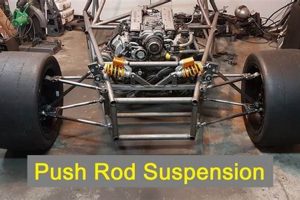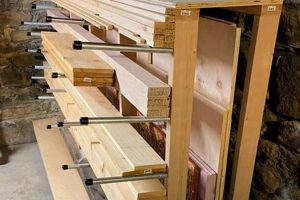Constructing automated cutting or engraving machines at home represents a growing trend. This involves individuals sourcing components, writing software, and assembling electro-mechanical systems to replicate the functionality of industrial-grade equipment on a smaller scale. An example would be a self-built router capable of carving intricate designs into wood or plastic, controlled by a personal computer.
This approach offers several advantages, including substantial cost savings compared to purchasing pre-assembled units. Furthermore, it provides a deep understanding of machine operation, facilitating customization and repair. Historically, this endeavor was limited to individuals with advanced engineering knowledge, but advancements in open-source software and readily available parts have broadened accessibility.
The subsequent sections will delve into the key aspects of this practice, examining essential components, software options, construction methodologies, and safety considerations. These topics are crucial for anyone considering embarking on the creation of such a machine.
Guidance for Machine Construction
The following recommendations address crucial aspects for individuals engaged in self-directed machine fabrication, emphasizing precision and long-term operational effectiveness.
Tip 1: Secure a Rigid Frame. A solid foundation is paramount. Employ thick-walled steel or aluminum extrusions joined with robust fasteners. Minimize vibration through careful design and construction.
Tip 2: Implement Precise Linear Motion. Utilize linear rails and ball screws for smooth, accurate movement. Consider pre-loaded components to eliminate backlash and enhance precision.
Tip 3: Select an Appropriate Spindle or Laser. Choose a spindle with sufficient power for intended materials. For laser applications, prioritize wavelength and power output based on target materials and safety compliance.
Tip 4: Employ a Reliable Control System. Opt for a proven controller board and software package. Prioritize features such as step accuracy, g-code compatibility, and safety interlocks.
Tip 5: Implement Effective Dust Collection. Control particulate matter generated during machining. Use a dedicated dust collector or vacuum system to maintain a clean and safe work environment.
Tip 6: Calibrate and Test Thoroughly. After assembly, meticulously calibrate the machine. Run test cuts or engravings on scrap material to verify accuracy and repeatability. Adjust parameters as needed.
Tip 7: Prioritize Safety. Implement safety measures, including emergency stop switches, physical barriers, and proper ventilation. Always wear appropriate personal protective equipment.
Following these recommendations contributes to the creation of a more reliable, precise, and safer machine. Attention to detail during the construction process directly impacts the overall performance and longevity of the system.
The concluding section of this article will provide resources for further research and development in this field.
1. Frame Rigidity
Frame rigidity is paramount in the construction of automated cutting or engraving machines. It serves as the foundational element upon which all other components are mounted and relies on for achieving accuracy and precision. The frame’s ability to resist deflection under load directly impacts the overall performance and capabilities of the completed device.
- Impact on Accuracy
A flexible frame introduces errors in the positioning of the cutting tool. Even minute deflections, measured in microns, accumulate over the work area, leading to inaccuracies in the final product. A rigid frame minimizes these errors, ensuring that the tool follows the programmed path with greater fidelity. For example, when milling aluminum, a less rigid frame could cause chatter and a rough finish, while a sturdy frame promotes smooth cutting and tight tolerances.
- Vibration Damping
The frame’s material and construction influence its ability to dampen vibrations generated during the cutting process. Excessive vibration degrades surface finish, increases tool wear, and can even damage the machine itself. A frame constructed from dense materials and incorporating damping features minimizes these effects. A steel frame, for instance, offers superior vibration damping compared to a less dense material like plastic.
- Material Selection and Construction Methods
The choice of materials and construction techniques directly affects frame rigidity. Steel, aluminum, and composite materials are commonly employed, each offering a different balance of stiffness, weight, and cost. Welding, bolting, and epoxy bonding are used to join frame members. The most effective method depends on the material and the desired level of precision. Steel frames are often welded for maximum rigidity, while aluminum frames may be bolted or assembled with specialized connectors.
- Influence on Machine Size and Capacity
The required frame rigidity increases with the size and intended capacity of the machine. Larger machines with heavier workpieces necessitate more robust frames to prevent deflection. A small engraving machine intended for light materials may suffice with a lighter frame structure, whereas a large milling machine designed for cutting steel requires a substantially more rigid frame.
In essence, frame rigidity forms the bedrock of the entire system. Careful consideration of material selection, construction techniques, and design principles is crucial for achieving the desired levels of accuracy, precision, and overall performance. A well-designed and constructed frame translates directly into a more capable and reliable cutting or engraving machine.
2. Motion Control
Motion control represents a critical functional component. Precise and coordinated movement of the cutting tool or workpiece defines the machine’s accuracy and overall capabilities. The selection and implementation of appropriate motion control systems directly impact the quality of the finished product, the speed of operation, and the reliability of the system.
In such projects, motion control typically involves stepper motors or servo motors driving linear actuators, such as lead screws or ball screws. The chosen actuators translate rotary motion into linear motion, enabling precise positioning along the X, Y, and Z axes. Microcontroller-based systems, often employing specialized motor driver integrated circuits, govern the motors’ movement based on instructions from computer-aided manufacturing (CAM) software. For instance, creating a complex 3D model necessitates simultaneous and coordinated movement across all axes, a capability reliant on a well-tuned motion control system. Without accurate motion, intricate details are lost, and dimensional
errors accumulate.
Successful implementation of motion control systems requires careful consideration of factors such as motor torque, actuator resolution, feedback mechanisms (e.g., encoders), and control algorithms. Inadequate motor torque results in missed steps and inaccurate positioning. Insufficient actuator resolution limits the achievable precision. Lack of feedback mechanisms hinders error correction and closed-loop control. Therefore, understanding the intricacies of motion control and its integration within the broader system is essential for achieving satisfactory performance in any machine construction endeavor. The ability to precisely control movement is what allows the diy cnc machine to follow intricate designs and instructions.
3. Spindle Selection
The selection of an appropriate spindle is a pivotal decision in constructing a custom automated cutting or engraving machine. The spindle directly influences the range of materials that can be processed, the speed and quality of machining operations, and the overall versatility of the final device. Careful consideration must be given to various factors to ensure optimal performance.
- Power and Torque Requirements
The spindle’s power rating dictates the ability to remove material effectively. Harder materials, such as steel, require higher power spindles to maintain cutting speed and prevent stalling. Torque, conversely, defines the spindle’s ability to resist twisting forces during machining. Insufficient torque can lead to reduced material removal rates and poor surface finishes. For example, a project involving aluminum milling necessitates a spindle with ample power and torque to avoid chatter and achieve smooth cuts.
- Speed Range and Control
The spindle’s speed range must align with the recommended cutting speeds for the intended materials and tooling. Variable speed control enables the operator to optimize cutting parameters for different applications. A spindle with a wide speed range allows for greater flexibility in material processing. When engraving soft materials like wood, higher speeds are generally employed, while slower speeds are preferred for cutting harder metals.
- Runout and Accuracy
Runout refers to the amount of radial deviation of the spindle’s rotating axis from its true center. Excessive runout introduces inaccuracies in machining operations, leading to dimensional errors and poor surface finishes. Spindles with low runout are essential for precision work. A spindle with high runout, might cause the creation of a circular feature to appear more like an oval.
- Cooling Methods and Durability
Spindles generate heat during operation, and adequate cooling is crucial for preventing overheating and extending their lifespan. Air-cooled spindles are simpler to implement, while liquid-cooled spindles offer superior heat dissipation. The spindle’s construction and bearing design influence its durability and resistance to wear and tear. Heavy use of any spindle requires proper cooling to avoid failure.
Ultimately, spindle selection represents a critical balancing act between performance requirements, budget constraints, and ease of integration. Choosing a spindle that aligns with the intended applications and material types is essential for achieving satisfactory results and maximizing the potential of the completed project. A well-chosen spindle is an essential investment in ensuring quality and effectiveness of a homemade cutting or engraving machine.
4. Software Suite
The functional capabilities of a custom automated cutting or engraving machine are inextricably linked to its software suite. This software serves as the interface between the operator and the hardware, translating design specifications into precise machine movements. Without a comprehensive and well-integrated software system, the mechanical potential of even the most meticulously constructed machine remains unrealized. A design created in a CAD program must be translated into machine-readable code, commonly G-code, which then instructs the machine’s control system. The software suite, therefore, acts as the critical intermediary in the entire process, defining the scope and precision of what the machine can achieve.
A typical software suite includes CAD (Computer-Aided Design) software for creating or modifying designs, CAM (Computer-Aided Manufacturing) software for generating toolpaths and G-code from the CAD design, and control software for interpreting the G-code and controlling the machine’s movements. For example, a complex 3D carving project necessitates advanced CAM software capable of generating efficient and precise toolpaths, taking into account factors such as tool geometry, material properties, and desired surface finish. Similarly, the control software must be robust and reliable, ensuring accurate execution of the G-code commands and providing real-time feedback on the machine’s status. Open-source options, such as FreeCAD and LinuxCNC, provide cost-effective alternatives to commercial software, although they may require a steeper learning curve.
In essence, the software suite forms the brain of a build, dictating its operational parameters and influencing the quality of its output. Selection of appropriate software, along with expertise in its effective utilization, is paramount for realizing the full potential of the hardware investment. Addressing challenges related to software compatibility, proper configuration, and skillful operation contributes directly to the successful construction and effective application of a custom automated cutting or engraving machine.
5. Safety Systems
The construction of an automated cutting or engraving machine necessitates a comprehensive approach to safety. Due to the inherent risks associated with high-speed rotating tools, lasers, and electrical components, integration of robust safety systems is not merely advisable, but essential. The absence of adequate safety measures can lead to severe injuries, equipment damage, and potential fire hazards. Consider a scenario in which a cutting tool breaks during operation. Without a protective enclosure or emergency stop mechanism, ejected fragments pose a significant projectile hazard.
Effective safety systems incorporate multiple layers of protection. Emergency stop switches provide immediate power cutoff in the event of a malfunction. Enclosures constructed from impact-resistant materials contain debris and reduce noise levels. Interlocks prevent operation when doors or access panels are open. Limit switches prevent over-travel of axes, safeguarding against mechanical damage. Fume extraction systems mitigate the inhalation of harmful particles generated during cutting or engraving. The implementation of these systems depends upon the specific design and application. A laser engraver, for example, requires laser-rated safety glasses and enclosures designed to block the laser’s wavelength, whereas a router necessitates effective dust collection to minimize respiratory hazards.
Ultimately, a build that prioritizes safety demonstrates a commitment to responsible engineering practices. Thorough risk assessment, meticulous system
design, and adherence to relevant safety standards contribute to a safer and more productive operating environment. Proper safeguarding not only protects the operator but also enhances the longevity and reliability of the machine itself. Ignoring the safety component is a critical oversight that can lead to dangerous consequences. A successful machine combines functionality with rigorous safety protocols.
6. Calibration Accuracy
In the realm of self-constructed automated cutting and engraving machines, achieving precise and repeatable results hinges critically on calibration accuracy. This encompasses the process of aligning the machine’s physical movements with the intended design, ensuring that the final product adheres to the specified dimensions and tolerances.
- Importance of Axis Alignment
Accurate alignment of the X, Y, and Z axes is fundamental. Misalignment introduces skew and distortion, leading to inaccuracies in the manufactured parts. Consider a scenario where the X-axis is not perfectly perpendicular to the Y-axis. This error, even if seemingly minor, accumulates over larger distances, resulting in significant deviations from the intended shape. Correcting this requires precise measurements and adjustments, often utilizing shims or adjustable mounting hardware. A properly aligned system provides consistent and predictable results.
- Step Resolution and Motor Calibration
Stepper motor-driven systems require careful calibration to ensure that each step corresponds to the intended linear movement. Variations in motor performance, leadscrew pitch, and micro-stepping settings can introduce errors. Calibration involves measuring the actual movement per step and adjusting the control software accordingly. For example, if the calculated movement per step is consistently off by a small percentage, the steps per millimeter setting in the control software must be adjusted to compensate. Accurate motor calibration ensures that the machine moves the correct distance for each command.
- Backlash Compensation
Backlash, the play or looseness in mechanical components such as gears and leadscrews, introduces inaccuracies when the direction of movement changes. Compensation mechanisms, implemented in either hardware or software, mitigate the effects of backlash. Software-based compensation involves adding a small amount of movement to account for the lost motion. Hardware-based solutions involve preloading the leadscrew or using anti-backlash nuts. Effective backlash compensation improves the machine’s ability to accurately execute intricate designs with frequent changes in direction.
- Workpiece Zeroing and Datum Establishment
Establishing an accurate workpiece zero point, or datum, is crucial for aligning the machine’s coordinate system with the physical location of the material being machined. Errors in zeroing introduce offsets and scaling issues. Techniques such as probing, edge finding, or visual alignment are used to precisely locate the workpiece. Accurate zeroing ensures that the design is accurately positioned on the material, preventing wasted material and dimensional errors. Without a precisely set zero, projects may start at the incorrect location and lead to the design being cut off.
In conclusion, achieving and maintaining calibration accuracy is an ongoing process in building and operating this kind of machines. By carefully addressing factors such as axis alignment, step resolution, backlash, and workpiece zeroing, it is possible to achieve a level of precision that rivals commercial equipment. Calibration accuracy forms the cornerstone of a successful machine project, directly influencing the quality, consistency, and repeatability of the final product. A well calibrated system creates precise results.
Frequently Asked Questions Regarding Self-Constructed Automated Cutting or Engraving Machines
The following section addresses common inquiries and concerns surrounding the construction and operation of custom automated cutting or engraving machines. The information presented aims to clarify misconceptions and provide practical guidance for prospective builders.
Question 1: What is the typical cost associated with constructing such a machine?
The financial investment varies significantly depending on factors such as machine size, component quality, and intended functionality. A small-scale machine for hobbyist applications may cost several hundred dollars, while a larger, more robust machine capable of handling demanding materials can easily exceed several thousand dollars. Careful budgeting and component selection are essential for cost control.
Question 2: What level of technical expertise is required for successful construction?
While prior experience in electronics, mechanics, and computer programming is beneficial, it is not strictly essential. Numerous online resources and communities provide detailed instructions and support for novice builders. However, a willingness to learn and troubleshoot is crucial. Familiarity with basic hand tools and safety procedures is also required.
Question 3: What are the primary safety considerations when operating such a machine?
Safety is paramount. Eye protection, respiratory protection, and appropriate clothing are mandatory. Emergency stop switches must be readily accessible. Proper grounding of electrical components is essential to prevent electrocution. Adequate ventilation is necessary to remove hazardous fumes generated during machining. Furthermore, secure workholding is crucial to prevent workpiece ejection.
Question 4: What software is typically used to control these machines?
Common software options include open-source programs such as LinuxCNC and commercial software packages such as Mach3 and Fusion 360. The selection depends on the machine’s control system, the operator’s familiarity with the software, and the desired level of functionality. All software requires a computer or laptop with the minimum requirements for smooth and accurate processing.
Question 5: What materials can be processed with a self-constructed automated cutting or engraving machine?
The range of processable materials depends on the machine’s rigidity, spindle power, and tooling. Softer materials such as wood, plastic, and foam are readily machined with less powerful machines. Harder materials such as aluminum and steel require more robust machines with higher spindle power and appropriate cutting tools. The load, speed, and cutter must be specific to the type of material the machine handles.
Question 6: What are the key advantages of building such a machine versus purchasing a pre-assembled unit?
The primary advantages include cost savings, customization options, and a deeper understanding of machine operation and maintenance. Building offers the opportunity to tailor the machine to specific needs and budgets. Additionally, construction provides invaluable experience in troubleshooting and repairing the machine, minimizing downtime. The flexibility for changes, upgrades, and new designs are virtually endless.
In summary, the construction of an automated cutting or engraving machine offers numerous benefits, including cost savings and enhanced knowledge. However, potential builders must carefully consider the technical challenges and safety implications involved.
The following section will delve into resources for additional research and developme
nt.
Conclusion
This article has explored the various facets of self-constructed automated cutting or engraving machines. Key points include frame rigidity, motion control precision, spindle selection, software suite integration, and safety system implementation. Successful machine construction necessitates a thorough understanding of these interconnected elements and a commitment to diligent execution.
The pursuit of proficiency in the area of “diy cnc” demands continuous learning and refinement. While this article provides foundational knowledge, further independent research and community engagement are vital for achieving optimal results. The future of this lies in the hands of its practitioners, who must uphold rigorous standards of engineering and safety.







